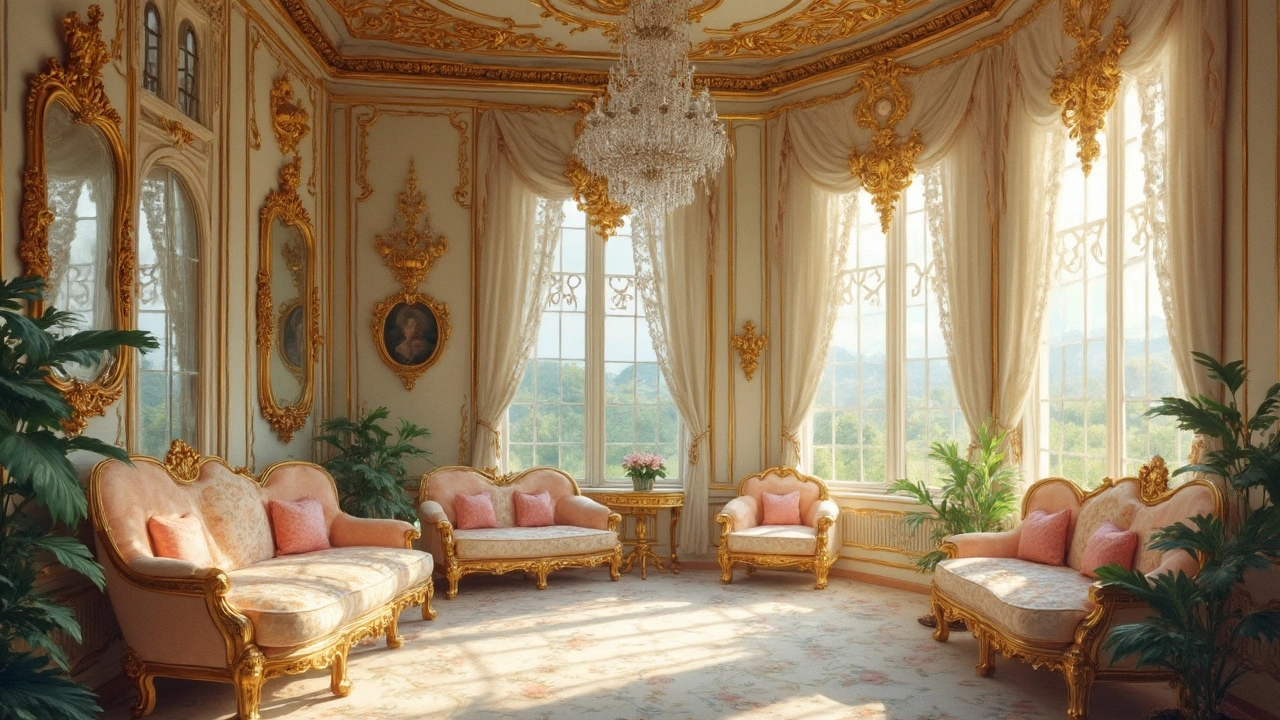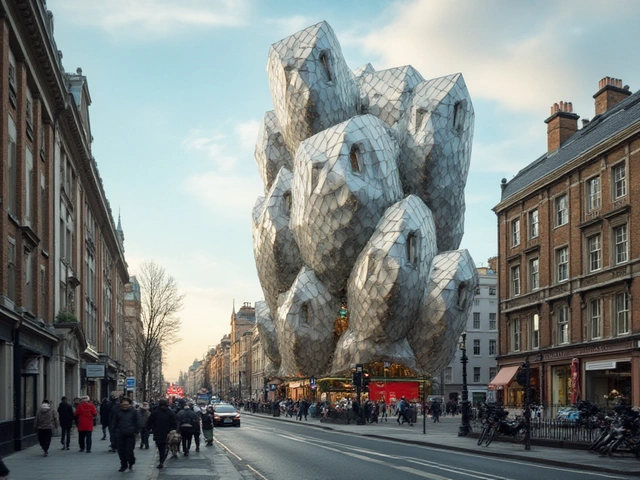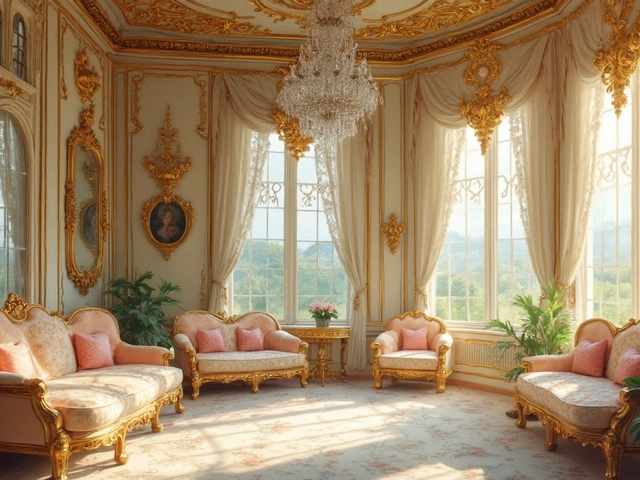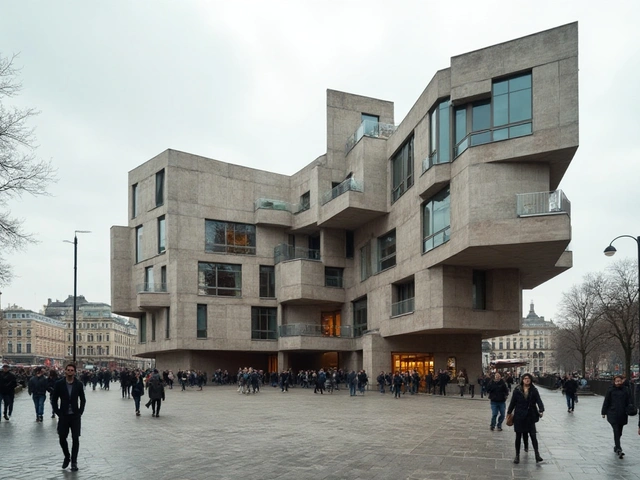Rococo design is like the ultimate expression of lighter and more playful vibes in the world of artistic styles. Born in 18th-century France, it was all about breaking free from the heavy drama of Baroque. If Baroque was the serious business suit of art, Rococo was the flowing, intricately detailed party gown.
This style is super easy to spot once you know what to look for. Think curvy lines, pastel colors, and lots of nature-inspired motifs. It's like the design world did a 180, opting for elegance over enormity. Whether you're checking out a piece of furniture or an old building, Rococo often feels like art that didn’t take itself too seriously but was serious about beauty.
Rococo is not just about looking at the past; it's about feeling the charm of a time when design was a game of balance and fun. For anyone tinkering with interior design or just a fan of the decorative arts, diving into Rococo can feel like a whimsical journey where elegance meets playfulness.
- Origins of Rococo
- Characteristics of Rococo Design
- Influence on Furniture
- Rococo in Architecture
- Decorative Arts and Rococo
- Modern Inspirations
Origins of Rococo
The story of Rococo begins in the early 18th century, right in the heart of France. Imagine the grand Baroque style with its heavy textures and themes dominating the scene. Well, folks back then were ready for a change. That's where Rococo comes in, bringing a breath of fresh air with its lighter and more whimsical approach.
This new style started in the salons of Paris, where the aristocracy loved to entertain and show off their taste. It was all about creating spaces that felt intimate, elegant, and playful. Artists and designers took inspiration from nature, swirling and curving lines like vines in their work. Everything was about elegance and grace, but in a way that was approachable and fun.
One of the cool things about Rococo was how it spread beyond just architecture—it influenced paintings, sculptures, and even fashion. Key figures like Jean-Antoine Watteau featured themes of love and nature in work that added to Rococo's charm. It was like the whole art world was in on this new chapter, moving away from the serious and towards the whimsical and light-hearted.
The influence of Rococo didn’t stop at the French borders, either. It quickly spread to other parts of Europe, resonating with places that were eager to embrace this fresh and vibrant style. Countries like Germany and Austria, for example, have some stunning Rococo architecture and art. It's fascinating how a single design movement could ripple out and touch so many aspects of culture and aesthetics across continents.
Characteristics of Rococo Design
Rococo design is like if you took art and gave it a playful twist with a flourish of elegance. This style thrived on being extravagant but in a way that exudes charm rather than overwhelming opulence. Some of its unmistakable traits make it a favorite in the world of interior design and art.
So, what are these traits? First off, Rococo is all about curves. Straight lines are out the door, and S- and C-shaped curves take center stage. It's as if someone decided that every surface needed to dance a little.
Another standout feature is the use of soft, pastel colors. Picture light blues, soft pinks, and creamy whites. These colors don’t shout for attention but invite you in like a gentle whisper.
Nature plays a big role, too. The motifs often include flowers, leaves, and shells. This love for natural forms brings a sense of harmony and liveliness into any space.
Also, intricate detailing is a must. Whether it’s on the furniture or the architecture, you’ll find lots of ornamental features like scrolls, ribbons, and cherubs. It’s all about celebrating the joy found in the smaller details.
Textures are varied, often mixing wood, gilding, and mirrors to make rooms feel both luxurious and light. This mix helps balance out the detail work, ensuring that each element enriches the whole.
Lastly, Rococo loves asymmetry and freedom. It’s not bound by strict rules or symmetry, which lets creativity flow, making each piece or room unique.
- Sweeping curves and lines
- Soft and pastel colors
- Nature-inspired motifs
- Extensive detailing
- Mix of materials and textures
- Asymmetry
These characteristics not only define Rococo but also make it a timeless style, keeping rooms elegant yet playful. It's a harmonious dance between beauty and fun.
Influence on Furniture
The Rococo style left quite the mark on furniture, turning what was once more bulky and grand into something far more light and comfortable. During the 18th century, the design of chairs, tables, and cabinets shifted to embrace an ornate yet delicate aesthetic. French artisans, always at the forefront of fashioning stunning designs, started crafting pieces that seemed to dance with their curving lines and playful details.
One of the key features of Rococo furniture is its love affair with intricate carving. Furniture pieces often have detailed motifs of shells, flowers, and scrolls, bringing nature right into the living room. These weren’t just stuck on as afterthoughts; they were integral to the design, flowing seamlessly across the furniture's surface.
If you ever stumble across a Rococo chair, give it a test sit. These chairs often have what's called a cabriole leg, which curves out and down like a smooth 'S.' It’s not just about looks—these designs were actually more ergonomic than their predecessors. Plus, plush upholstery was a must, with rich fabrics like brocade or damask, making sure you sat like royalty even if you weren’t one.
Ever heard of a table with curved edges? Yep, that's a Rococo trait too. The style favored tables with rounded shapes over the straightforward rectangular. Add in some gilt finishes and you’ve got yourself a classic. Cabinets and commodes were another playground where artisans showcased their skills with veneering and lacquer techniques, often giving an illusion of greater intricacy and depth.
- Light and intricate carving details
- Organic motifs inspired by nature
- More ergonomic, comfort-focused designs
- Unique fabrics and upholstery choices
- Iconic curvy features like cabriole legs
Even today, Rococo furniture inspires modern pieces that aim to combine opulence and comfort in new ways. Next time you’re picking out a piece of furniture, maybe let the playful elegance of Rococo guide your choices.
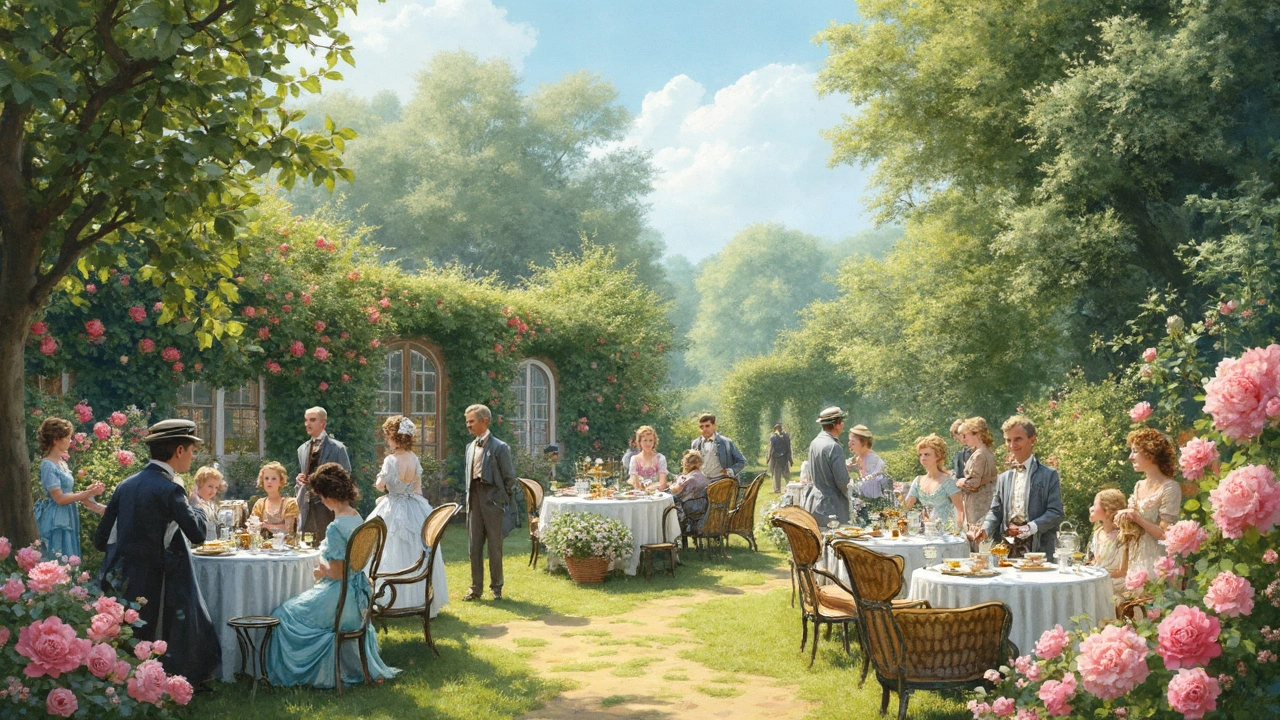
Rococo in Architecture
Rococo architecture is like a playful twist on the old classics, particularly shaking things up in the grand houses and estates of Europe. Gone were the hulking facades of Baroque; in came lighter, more decorative aspects that made buildings feel a bit more, well, lived-in and cozy. Think of it as mixing a bit of whimsy into the sturdy structures.
When you look at Rococo architecture, you can't miss the love for curves. The smooth, flowing lines are a signature move. It's like everything refuses to sit still! Buildings during this time were full of twisting staircases, elaborate frescoes on the ceilings, and walls that seemed to dance with ornamentation. Churches, palaces, and even theaters embraced this playful elegance, creating spaces that seemed more like art than mere function.
If we’re talking specifics, one can't ignore Bavaria's Wieskirche in Germany. This rococo church is decked out with elaborate stucco work, lots of gilding, and an air of divine lightness that seems to lift the spirit up. In France, rooms in the Château de Chantilly are a testament to how Rococo decor and architecture merge, with everything from the ceiling moldings to the tiniest green space outside meticulously crafted for aesthetic pleasure.
Rococo wasn't just about appearances, though. It changed the game by playing with how space was used. Interiors became more intimate, with rooms serving more specific purposes, a nod to comfort and day-to-day use over the imposing big halls of the past. You could say Rococo was kind of an early take on open-plan living.
The style didn’t just hang around in Europe. Its echoes reached as far as Russia, influencing some parts of the magnificent Catherine Palace in Saint Petersburg, where you can see elements of Rococo flirting with Russian opulence. This global influence shows how irresistible the whimsical charm of Rococo can be.
Overall, Rococo architecture is a reminder that buildings aren’t just shelters—they can also be expressions of artistry and taste. And its legacy continues to inspire architects today who seek to blend functional beauty with that timeless, unmistakable charm.
Decorative Arts and Rococo
When it comes to the world of Rococo decorative arts, think of an elegant explosion of creativity. Born in the 18th century, this style truly spread its wings in furniture, ceramics, and even fashion. What made it unique was how it shifted towards asymmetry and light-hearted themes, far removed from the strict symmetry of the earlier Baroque era.
In furniture, for example, you’d see lots of playful curves and intricate ornamentation. Chairs and tables became more than just functional pieces; they turned into artwork. French craftsmen created masterpieces that were adorned with gilded wood, floral carvings, and even scenes from nature. It was all about mixing beauty with a touch of fantasy.
Ceramics, too, saw a Rococo flair. European porcelain factories, like those in Meissen and Sèvres, pushed the limits of creativity. They weren’t just making regular tableware; they were crafting pieces that could stand alone as art. Think vivid colors, whimsical figurines, and lots of gold accents. Dinnerware often featured scenes from everyday life or pastoral themes, adding a touch of humor and lightness.
While some might think of it as just a period of extravagance, Rococo decorative arts were really about celebrating art as part of daily life. Items weren't designed just to look good; they were meant to infuse spaces with happiness and charm. This approach to design paved the way for future periods, where blending functionality with aesthetic appeal became the norm.
Even today, bits of Rococo style pop up in modern decor, like intricate wall moldings or elegantly carved mirror frames. It’s a testament to its timeless appeal and how it's managed to hold onto its place in art history as a style that balances unrestrained beauty with everyday function.
Modern Inspirations
So, how does the Rococo spirit survive in our modern world? Funny enough, it sneaks into our designs more often than you'd think, adding a touch of elegance to contemporary spaces. Today's designers love to borrow from the past, and Rococo offers a treasure trove of ideas, especially when blending the old with the new.
In interior design, you'll spot Rococo's influence in rooms that balance ornate details with modern functionality. Think about opulent mirrors with beautifully intricate frames set against sleek, minimalist furniture. Or those swooping curves seen in rococo architecture turning up in modern chair designs. The key is mixing the elaborate with the straightforward, creating a fresh aesthetic that feels both familiar and new.
Even in fashion, Rococo's playful elegance pops up. Brands occasionally dive into the past for inspiration, creating clothing lines with elements like ruffles, pastel hues, and floral patterns, echoing Rococo themes. It's like they're telling us style doesn’t just evolve in a straight line; it's more of a loop, revisiting what's tried and true, and then giving it a twist.
- Curved furniture pieces add depth and character.
- Pastel wall colors soften the mood of a room.
- Nature motifs in decor bring a calm, natural vibe.
- Layering textures with fabrics and wallpaper adds complexity.
The art world hasn’t escaped Rococo’s grip either. Exhibitions sometimes feature works inspired by this art period, bringing the playful nature of Rococo into galleries. It’s a reminder that fluidity and ornamentation can have a place in modern settings.
Designing with Rococo charm isn't just about copying the past; it's about reimagining it and making it work in today's lifestyle. It's fun, eclectic, and, above all, a reminder that style is timeless when it evolves thoughtfully.

